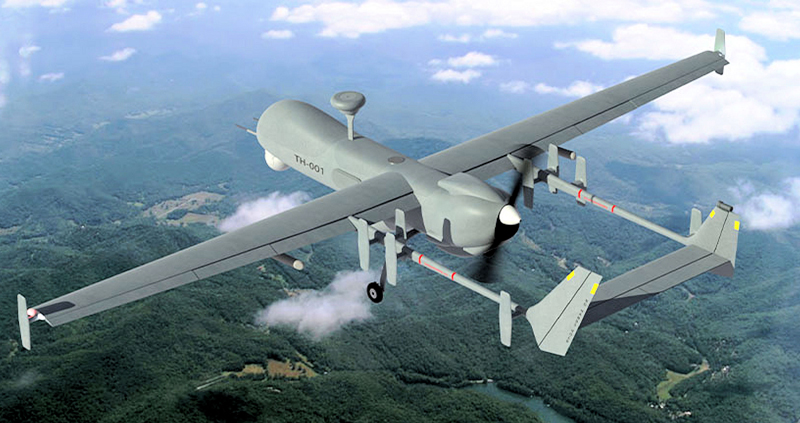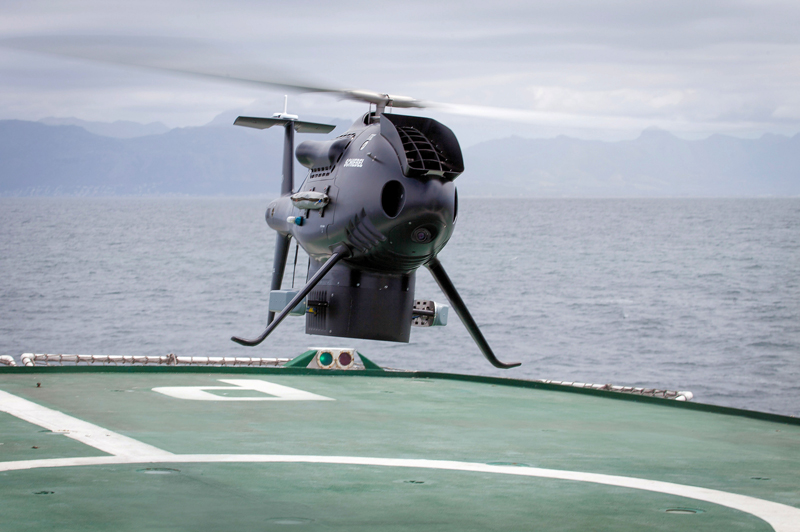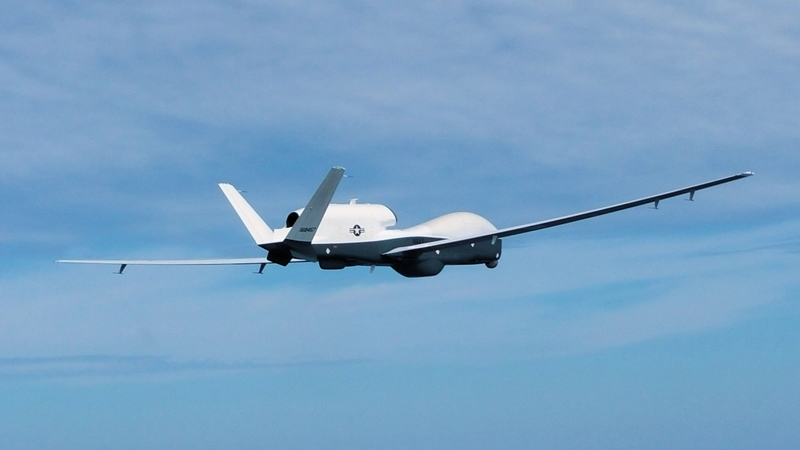
Unmanned aerial vehicles now have the flexibility and endurance to deliver SIGINT to Asian military operators.
UAVs
The idea of using unmanned aerial vehicles (UAVS) as platforms for SIGINT [1] collection is not new, with South-East Asia hosting one of the first modern era examples when the United States utilised what were then known as ‘drones’ to capture an electronic picture of the engagement sequence of the Russian SA-2 surface-to-air missile during the second Indo-China war in the 1960s and early 1970s.
Today, medium- and high-altitude long-endurance (MALE and HALE) UAVs are becoming increasingly attractive in the SIGINT role in that they provide persistence, deniability and, increasingly, the ability to function as multi-sensor surveillance platforms.
These MALE and HALE systems are able to remain on station for extended periods (days in some cases) thereby providing continuous coverage with fewer assets than would be required for an equivalent manned capability and one which is ‘deniable’ in that there is no pilot and/or crew to be captured in the event of a shoot down.
[1] Signals intelligence (SIGINT) is an umbrella term that covers a number of sub-disciplines, the most important of which are communications intelligence (COMINT), electronic intelligence (ELINT) and telemetry intelligence (TELINT). In order, COMINT concerns itself with the interception of radio frequency (RF) communications links, while ELINT looks at non-communications signals such as those produced by radars. For its part, TELINT refers to the collection of RF data associated with the monitoring of weapons such as ballistic missiles during test campaigns.
Miniaturisation
Advances in both miniaturisation and technological capability mean that there is increasingly more ‘bang per buck’ inherent in equipment that is small enough to fit the necessarily constrained space envelopes available in even the largest of UAVs.
Elsewhere, miniaturisation has opened the possibility of multi-sensor payloads, although the SWaP (space, weight and power) straitjacket still constrains what can be carried, powered and used simultaneously with other onboard systems.
SWaP considerations become less stringent when the collection equipment is carried by unmanned aerostats which can lift considerable weights and draw power and control instructions via their tethers.
Taking these various factors together, it is not hard to see that UAV-based SIGINT collection is an increasingly attractive proposition in the Asia-Pacific region in view of its vast geographical spread and regional tensions built around status, territorial disputes and exploitation of the area’s natural resources.
SIGINT Suppliers
As might be expected, a number of manufacturers around the world have produced SIGINT equipment that is suitable for installation aboard UAVs, with systems originating from countries as diverse as Germany (exemplified by Raytheon Deutschland’s Advanced Radar Detection System or ARDS), Israel (Elta Systems’ ELK-7071 and ELL-8385 equipments together with Elbits’s SKYFIX system), Pakistan (East West Infiniti’s ECOM WisperWatch), South Africa (Saab’s Electronic Surveillance Payload or ESP), the UK (Leonardo’s SAGE) and the US (BAE Systems’ Tactical SIGINT Payload (TSP), L3Harris’ (formerly Exelsis) AR-900, Northrop Grumman’s (NG) Airborne SIGINT Payload (ASIP) and the Sierra Nevada Corporation’s (SNC) AN/ZLQ-1 system).
Raytheon Deutschland’s ARDS
Looking at these in more detail, Raytheon Deutschland’s ARDS is a pod-mounted ELINT system that has been integrated with and tested aboard General Atomics’ MQ-9B Predator MALE platform and which can be configured to cover the one to 40 GHz frequency band; offers <100 kHz accuracy against pulsed signals (<10 kHz against continuous wave ones); has a 5kHz frequency resolution and a 1GHz instantaneous bandwidth and has sensitivity and direction-finding (DF) accuracy values of – 84dBm and <0.5° (antenna array dependent) respectively.
Significantly, ARDS is also billed as being International Traffic in Arms Regulations (ITAR) – free. Looking specifically at the Asia-Pacific region, Australia has selected the MQ-9B to fulfil its Project Air 7003 requirement and it would not be unreasonable to speculate that a capability such as that provided by ARDS or Leonardo’s SAGE system (see following) would be a most useful adjunct to this acquisition.

Elta’s ELK-7071 and ELL-8385
For their parts, Elta’s ELK-7071 and ELL-8385 are UAV compatible COMINT/DF and electronic support (ES)/ELINT systems respectively. Of the two, ELK-7071 is built around a 279(W)×208(H)×540(L)mm multi-channel COMINT sensor (MCCS) and makes use of calibrated interferometry for DF.
Again, the MCCS weighs in at 30kg and the system as a whole has a power consumption of between 350-700W. Frequency coverage is given as being 20MHz to 3GHz (extendable up to 6GHz), with DF accuracy being claimed to be ‘better than’ 2° RMS.
Again, ELK-7071 makes use of multiple ‘plate’ collection antennas; is supported by real-time/off-line analysis tools; can process both data and voice traffic and can direction-find against fixed frequency and frequency hopping emitters.
For its part, the ELL-8385 is billed as covering the 0.5 to 18GHz frequency band (with 0.5 to 1GHz and 18 to 40GHz options) and as being designed to provide ES situational awareness, early warning, passive air situation picture, real-time electronic orders of battle as well as intercepted signal analysis.
Again, the system provides automatic radar emitter identification and makes use of scab-on lateral antenna arrays which are made-up of arrangements of four large and four small circular elements per array.

Elbit Systems SKYFIX
The remaining cited Israeli exemplar – Elbit Systems SKYFIX – is (like Elta’s ELK-7071) a UAV configured COMINT system that covers the 30MHz to 1.2GHz frequency range (expandable to 30MHz to 3GHz) and which can be configured for COMINT/DF and mobile/satellite telephone interception.
As a COMINT/DF system, SKYFIX utilises correlative interferometry and a wide aperture, vertically polarised, ‘high precision’ antenna array for DF; provides 360° coverage in azimuth and –15° (–40° with degraded performance) to +2° in elevation; consumes <250W of power and weighs in at <35kg.
At the time of writing, all three of the described Israeli systems were being promoted, with SKYFIX known to have been demonstrated on Elbit’s Hermes 450 air vehicle (AV), while Elta’s ELK-7071 and ELL-8385 have been associated with Israel Aerospace Industries’ (IAI) Heron family of UAVs.
Within the Asia-Pacific region, the Indian Air Force, the Republic of Korea’s Army (RoKA) and Republic of Singapore’s Air Force (RSAF) are known to have acquired Heron series UAVs, with at least two of the Singaporean examples being understood to be equipped with an as yet unidentified sensor fit beneath their bellies.
Low End SIGINT
ECOM WisperWatch SIGINT system
Marketed by the intriguingly named East West Infiniti concern of Islamabad, the ECOM WisperWatch SIGINT system is described as having been designed for armed forces who ‘cannot procure and maintain a high-end, manned SIGINT [platform]’. As such, the architecture can be packaged for installation aboard a ‘small’ UAV (ECOM WisperWatch UAV) or an aerostat (ECOM WisperWatch Aero).
Again, WisperWatch incorporates a two to 10 channel scanning receiver (used for both search and monitoring); can either store acquired data aboard its host vehicle or download it to an associated ground station; covers the 0.5MHz to 4GHz frequency band; has a range of up to 130km when deployed on an aerostat that is being flown at an altitude of 3,281ft/1,000m (more than 225km when operated from a UAV flying at 9,843ft/3000m) and offers mission endurances of between six hours (UAV) and seven days (aerostat).
As of this writing, no WisperWatch applications have been discovered and it remains uncertain as to whether or not East West Infiniti still includes ECOM WisperWatch in its ‘military electronics solutions’ portfolio.
Saab’s ESP system
No such uncertainty surround’s Saab’s ESP system which the contractor describes as being ‘in service’ aboard a Seeker II UAV application (thought to be (but not confirmed as being) Algeria).
As such, ESP covers to 0.5 to 18GHz frequency band and utilises phase and amplitude comparison and intra-pulse channel switching (‘single pulse’) DF. Other parameters include a frequency resolution of 1MHz; a 100MHz (narrow band) or 1GHz instantaneous bandwidth; 1° RMS DF accuracy at above 2GHz (3.5° RMS at 700MHz); angular coverage of 210° in azimuth (three sectors) and 70° in elevation and a system weight of 16kg (comprising a 10kg, 343×127×193mm control unit and a 6kg antenna array).
Leonardo’s SAGE ES system
Turning to Leonardo’s SAGE ES system, the contractor describes it as a scalable, multi-platform equipment that can cover the 0.5 to 40GHz frequency band and is designed to provide both situational awareness and ‘[ELINT] type analysis’.
Other system features include interferometric DF (with a typical angle-of-arrival measurement accuracy of 1° RMS); single platform geo-location; a data recording facility and the ability to identify and categorise ‘complex’ emitter types.
Within the UAV domain, SAGE applications are known to have been trialled aboard Leonardo’s fixed-wing Falco EVO and Schiebel’s rotary-winged S-100 Camcopter air vehicles and the device is further understood to be the subject of a partnership agreement between Leonardo and General Atomics with regard to a SAGE fit aboard the MQ-9B platform.
Within the Asia-Pacific region, Pakistan is understood to have procured Leonardo’s first generation Falco UAV and it is not known whether or not these platforms incorporate an ES/SIGINT capability.
The remain four cited systems – the SNC’s AN/ZLQ-1, NG’s Airborne SIGINT Payload (ASIP), L3Harris’s (formerly Argo) AR-900 and BAE Systems’ Tactical SIGINT Payload (TSP) – all originate from America and are (collectively) applicable to both free flying and aerostat UAVs.

BAE Systems’ TSP
Taking them in reverse order, BAE Systems’ TSP has been procured for use aboard the US Army’s MQ-1C Gray Eagle platform and is described as being a ‘sensor system [that is] capable of processing conventional, modern and standard military signals from a single payload’.
Again, the device is described as being modular and scalable; as being a software-defined architecture and, as applied to the MQ-1C, is pod-mounted, with the housing being carried on the vehicle’s starboard inner wing pylon. Other system features include use of commercial off-the-shelf (COTS) hardware and remote operation at both line-of-sight (LOS) and beyond LOS ranges.
L3Harris’s AR-900
For its part (and although originally intended for shipboard use and now approaching obsolescence), the AR-900 is included as an example of an aerostat-mounted equipment. As such, it is known to have formed part of the sensor fit aboard Kuwait’s low-altitude surveillance system (KLASS).
Digging down, AR-900 covers the 2 to 18GHz frequency band; has a frequency resolution and DF accuracy of 1MHz and between 1° and 3.5° and makes use of a 28kg, 37×59cm antenna assembly that incorporates eight broadband spiral elements for DF.
NG’s ASIP
Turning to the cited NG product, ASIP is characterised as being a modular and scalable SIGINT payload that is currently in service aboard Lockheed’s high-altitude U-2 reconnaissance aircraft and NG’s RQ-4 Block 30 Global Hawk UAV.
Functionally, ASIP is an open architecture that is capable of detecting, identifying and locating radars and other types of electronic and ‘modern’ communications signals in ‘dense’ environments.
As applied to the Block 30 Global Hawk, ASIP is understood to take the form of a six chassis equipment that provides COMINT and ELINT direction-finding together with emitter geo-location and the ability to intercept telecommunications and ‘special signal’ transmission.
Again, Global Hawk ASIP can operated at altitudes of up to 60,000ft/ (18,288m) and utilises COTS components in direct spray cooled multi-platform enclosures. At the time of writing, the Republic of Korea was in the process of acquiring four RQ-4 Block 30 (I)s with which to bolster its national surveillance capability.
Here, onboard equipment is listed as including an electro-optic/infra-red imager, a synthetic aperture radar and a ‘signals intelligence’ package. Elsewhere in the region, Japan is also known to be procuring a trio of RQ-4 Block 30 (I) air vehicles which can be assumed to be similarly equipped to those being acquired by South Korea.
SNC’s AN/ZLQ-1
The remaining quoted system – the SNC’s AN/ZLQ-1 – is the ES system installed aboard the US Navy’s (USN) persistent MQ-4C Triton Broad Area Maritime Surveillance (BAMS) UAV and is described as being ‘all digital’, as providing 360° coverage in azimuth, as being capable of specific emitter identification and as incorporating an antenna array that includes a ventral radome mounted beneath the air vehicle’s rear fuselage.
Aside from any USN MQ-4C deployments in the region, the type is also being procured by Australia. Here, the requirement is for seven air vehicles, the second of which was ordered during April 2019.

China
Mention should be made of activity within the People’s Republic of China’s wide ranging UAV industry. Here, Beihang’s BZK-005E MALE platform is described as being able to accommodate an ELINT fit, while members of the Aviation Industry Corporation of China’s (AVIC) Wing Loong family of multi-role MALE UAVs are said to be capable of housing ‘electronic surveillance’ payloads.
Elsewhere, the China Aerospace Science and Technology Corporation’s (CASC) CH-4 vehicle has been photographed with a 1.5m long ‘electronic reconnaissance’ pod mounted on its ventral belly stores station. Equipped with an antenna array that includes four blade aerials, this payload is described as having been developed to ‘fulfil an unspecified customer’s requirements’.













